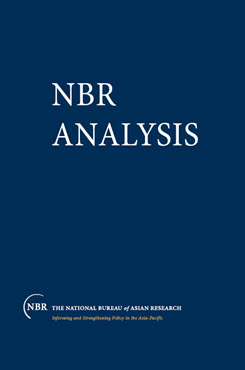America, APEC, and the Road not Taken
International Leadership in the Post-Cold War Interregnum in the Asia-Pacific
The United States is the nation most capable of providing the leadership needed to transform APEC into an international organization capable of facing the global and regional challenges of the incipient “Pacific century.” Why the United States is effectively the only candidate for leadership, why it has not taken the road of international leadership in the Pacific, and how this road may be traveled, are the subjects of this paper.
The Asia-Pacific Economic Cooperation (APEC) forum is at once promising and seriously flawed. Born in the year that the Cold War died, it has flourished as the only institution that encompasses the region destined to become the next center of the global political economy. Despite a narrow economic focus, a tiny operating budget, no real structure for decision-making, and a membership that is fundamentally diverse in terms of wealth, culture, politics, and the ways in which its economies operate, APEC has nevertheless prospered and grown as a forum for communication in this current interregnum between the end of the Cold War and the still inchoate new international order.
The flaws of APEC as a viable international organization in the long term are self-evident, fundamental, and potentially fatal. One flaw is its narrow focus. By dealing solely with economic matters, APEC not only ignores political-security issues, but essentially leaves in place the existing Cold War security arrangements in which the military burden falls on the United States. These arrangements, although officially accepted by the United States, are based on assumptions regarding threats, force structure, and diplomatic instruments (i.e., bilateral security treaties) that are rooted in the global strategic challenge of the Cold War, not in the narrower constabulary security issues that dominate Asia and the world in the post-Cold War era. Problems of burden-sharing, especially but not exclusively with regard to Japan, have reached proportions that are extreme and unsustainable in the long term. Unless it is assumed that peace will break out permanently or that future U.S. security policy will simply be an extension of the past, APEC must be part of a new Pacific and/or global security regime.
A second weakness is that APEC is not fully rooted in the legacies of the turbulent history of Asia of the last hundred years. During the 20th century, East Asia has been almost continuously beset by radical and rapid change: war, revolution, and now protracted and unprecedented economic growth. Two countries-China and Japan-have played and continue to play central roles in this ongoing Asian revolution. To succeed, APEC must flourish in the shadow of 20thcentury history, and modest goals like a timetable for free trade must be seen against the profound legacies of the past and the current challenges posed by the existence of two traditionally competitive Asian superpowers.
The challenges Japan and China present are daunting. Japan, a global economic superpower and the world’s largest creditor, has entered the current era with enormous economic resources but remains almost wholly devoid of international legitimacy, i.e., a capacity for leadership that transcends economic power alone. Tokyo has stood on the sidelines militarily during the post- Cold War era and still has to come to grips with the bitter legacy of Japan’s aggression during the 1930s and 1940s. Moreover, its domestic political problems-the party system is in turmoil and the bureaucracy is efficient but rigid-inhibit innovation in foreign policy. Japan is not now in a position to lead in Asia.
China, too, suffers from the burdens of its history. As Asia’s biggest and most rapidly developing nation and largest military power, it is currently in the midst of a domestic transfer of political power without an established framework to handle the succession. China remains a communist state in a post-communist world, and it lacks the legitimacy needed for international leadership. It is both blessed and burdened by the fact that overseas Chinese dominate most of the economies in Southeast Asia and are investing ever more of their capital in mainland China. How Japan and China integrate themselves into the international system will fundamentally shape not only APEC and the Asia-Pacific region, but the structure of the global system itself.
In its conception, operating procedures, and discussions about its future, APEC has an inward-looking and regional cast. Stress tends to be on the enhanced intraregional patterns of trade or APEC’s uniqueness (“Asian-ness”), making the forum a counterpoint to the more rule based European Union and North American Free Trade Agreement (NAFTA). In fact, APEC is important not because it is a new model for regional cooperation but because the Asia-Pacific region has moved to center stage in the global economy. If APEC is to flourish, it is imperative to address frontally and fully its role in the global economy.
The United States is the nation most capable of providing the leadership needed to transform APEC into an international organization capable of facing the global and regional challenges of the incipient “Pacific century.” Why the United States is effectively the only candidate for leadership, why it has not taken the road of international leadership in the Pacific, and how this road may be traveled, are the subjects of this paper.


